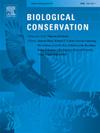德国狼再殖民化纸媒报道的话语分析
IF 4.4
1区 环境科学与生态学
Q1 BIODIVERSITY CONSERVATION
引用次数: 0
摘要
自世纪之交以来,狼已经重新在中欧的大片地区定居。虽然有些人认为这是保护的成功,但也有人强调狼重新出现所带来的问题。反映和塑造公众态度的媒体越来越多地被分析,以理解欧洲和美国的狼话语。本研究与本研究相联系,并通过应用结构主题模型来确定流行话题、时间趋势和空间差异,研究了2000年至2022年德国的印刷报道,之后狼自然回归。媒体分析包括两份全国性报纸——《图片报》(n = 242)和《本文章由计算机程序翻译,如有差异,请以英文原文为准。
A discourse analysis of print media coverage on the recolonization of the wolf in Germany
Since the turn of the century, wolves have recolonized large areas in Central Europe. While some view this as a conservation success, others emphasize the problems caused by the renewed presence of the wolf. Media, which both reflects and shapes public attitudes, has increasingly been analyzed to understand the wolf discourse in Europe and the U.S. The present study connects to this research and examines German print coverage from 2000 to 2022, following the natural return of wolves, by applying structural topic modeling to identify prevalent topics, temporal trends, and spatial differences. The media analysis covers two national newspapers—Bild (n = 242) and Süddeutsche Zeitung (n = 125)—and two regional papers, Lausitzer Rundschau (n = 1026) and Passauer Neue Presse (n = 268). The most frequent topics included lethal control, wolf monitoring, and livestock depredation, with educational work being prominent only in regional coverage. Over time, topics on wolf monitoring and educational work decreased in regional newspapers, while management issues increased. Differences were also observed between Bild (tabloid press) and Süddeutsche Zeitung (quality press). Bild focused on livestock attacks, while this was not a key topic in Süddeutsche Zeitung. The results show that in Germany the dissemination of information on monitoring and biological status is often of high-quality from wolf experts, which tends to generate trust. Further, the findings suggest that educational events, such as film festivals, and the reporting of monitoring results, could represent crucial instruments for spreading information about the conservational value of large carnivores, particularly by reaching a wide but also regional audience.
求助全文
通过发布文献求助,成功后即可免费获取论文全文。
去求助
来源期刊

Biological Conservation
环境科学-环境科学
CiteScore
10.20
自引率
3.40%
发文量
295
审稿时长
61 days
期刊介绍:
Biological Conservation is an international leading journal in the discipline of conservation biology. The journal publishes articles spanning a diverse range of fields that contribute to the biological, sociological, and economic dimensions of conservation and natural resource management. The primary aim of Biological Conservation is the publication of high-quality papers that advance the science and practice of conservation, or which demonstrate the application of conservation principles for natural resource management and policy. Therefore it will be of interest to a broad international readership.
 求助内容:
求助内容: 应助结果提醒方式:
应助结果提醒方式:


